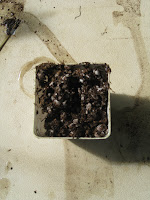 Some of my first tasks on the farm were cleaning up the nursery and the greenhouse. While the nursery just needed a little weeding and TLC, we had to
Some of my first tasks on the farm were cleaning up the nursery and the greenhouse. While the nursery just needed a little weeding and TLC, we had to  completely remove everything from the greenhouse due to an intense bug infestation on last years tomatoes, peppers and beans. So we picked what was left of all the veggies, and went to work removing everything from the greenhouse. With a totally clean slate, Terri and I went about
completely remove everything from the greenhouse due to an intense bug infestation on last years tomatoes, peppers and beans. So we picked what was left of all the veggies, and went to work removing everything from the greenhouse. With a totally clean slate, Terri and I went about  seeding some new little keikis (hawaiian for baby) to grow first in the nursery and then in the greenhouse.
seeding some new little keikis (hawaiian for baby) to grow first in the nursery and then in the greenhouse.First Terri showed me how it was possible to propagate tomatoes without seeds by using cuttings from the previous years plant. First and foremost it's important to start your new little seedlings with completely fresh clean soil (so you can avoid introducing new weeds). So we mixed up a fresh batch of peat, perlite and water (perlite is like this tiny lightweight rock almost that aerates the soil and aids in containing the moisture- better known as those random white specs you see in the soil or mulch you buy at the

 store). You then add the soil mixture into a small container, put a finger like hole, dip the root or piece of tomato vine in rootone (a natural hormone powder that helps roots grow faster), cover up the hole, water and place it in the shade to propagate!
store). You then add the soil mixture into a small container, put a finger like hole, dip the root or piece of tomato vine in rootone (a natural hormone powder that helps roots grow faster), cover up the hole, water and place it in the shade to propagate!Fact: There are 2 types of tomatoes- Determinate which will only grow to a certain height and Indeterminate which will grow on forever.
We also did a few keikis by just planting seeds in the old fashioned manner. Something that I had never really thought about, but Terri and I discussed was the importance of getting seeds locally, whether from local farmers or even local seed banks so that you get a seed variety that is already adjusted tot he climate you will be growing in. It's always good to save seeds from varieties that have grown particularly well so you can use them again in the next season.
If you have a seed of a plant that is of a particularly high value (ganja for example :) you may want to ge
 rminate them before you plant them. To germinate this type of seed you can put it in between two damp pieces of paper towels and wait until you see them start to burst open- then go ahead and plant them.
rminate them before you plant them. To germinate this type of seed you can put it in between two damp pieces of paper towels and wait until you see them start to burst open- then go ahead and plant them.Tip: To tell if a seed is still good or has gone bad- put them in a cup of water overnight and the bad ones will float to the top.
Update: Since the time that we planted all these little guys it's been about 2 weeks, they've grown into perfect little keikis and now we're ready take the next step and transplant them into the greenhouse!
1 comment:
i love reading all of your stories! and thanks for the tips :) can't wait till boston!
Post a Comment